Bt Hybrids for European Corn Borers and Corn Rootworms: Where's the IPM?
 |
Michael E. GrayProfessor of Entomology and Extension Coordinator Department of Crop SciencesPhone: (217) 333-6652 E-mail: megray@illinois.edu |
Ten growing seasons have elapsed since the commercialization (1996) of Bt hybrids for the management of European corn borers. More recently (2003), Bt hybrids became available for corn rootworm control. The popularity of these pest management tools continues to grow in corn production areas of the United States. The National Agricultural Statistics Service (NASS, USDA) estimated (June 30, 2005) that 81.6 million acres of corn was planted in the United States in 2005, an increase of 1% and 4% from 2004 and 2003, respectively. The use of Bt hybrids on 28.6 million acres accounted for 35% of the 2005 U.S. corn acreage. NASS estimated that 12.1 million acres of corn was planted in Illinois in 2005, of which 30% (3.63 million acres) was Bt hybrids. Five percent of the Bt hybrids planted in Illinois were the "stacked" gene varieties that include traits for herbicide and insect resistance. The use of Bt hybrids in western states was much greater than in eastern states in 2005: Illinois (30%) Indiana (15%), Iowa (46%), Kansas (33%), Michigan (20%), Minnesota (44%), Missouri (43%), Nebraska (51%), Ohio (11%), South Dakota (52%), and Wisconsin (28%). More continuous (non-rotated) corn acreage, greater livestock production, and fewer concerns about the overseas export market (particularly Europe) regarding transgenic grain help explain the greater use of Bt hybrids in western states. The use of transgenic corn (Bt and herbicide resistant) hybrids in 2005 exceeded 50% of planted acres in many Corn Belt states: Illinois (36%), Indiana (26%), Iowa (60%), Kansas (63%), Michigan (40%), Minnesota (66%), Missouri (55%), Nebraska (69%), Ohio (18%), South Dakota (83%), and Wisconsin (46%). The use of transgenic corn across the United States in 2005 was estimated at 52% of the planted corn acres. In 2005, 87% of the soybeans planted in the United States were herbicide resistant. In several midwestern states, the use of herbicide resistant soybeans exceeded 90% of the planted soybean acres.
Within a 10-year span, the manner in which producers control weeds and two very important insect pests of corn (European corn borer and corn rootworm complex) has fundamentally changed. This revolution has caused scientists engaged in integrated pest management (IPM) research and extension at Land Grant institutions to reexamine their definitions of IPM and to question some previously held convictions about IPM, which had its formal roots in the late 1950s.
Management of European Corn Borers with Bt Corn Hybrids
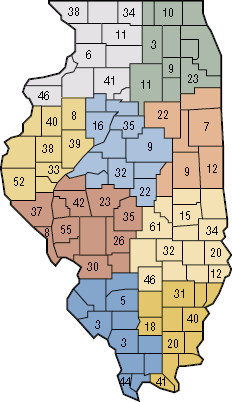
Figure 2 – Results from the 2005 survey of European corn borers. State average percentage infestation = 24%.
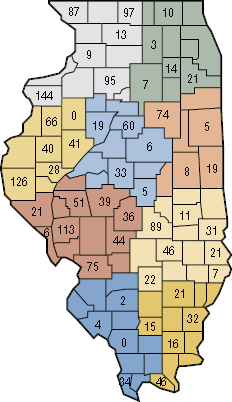
Figure 1 – Results from the 2005 survey of European corn borers. State average of borers per 100 plants = 34.
European corn borers were found for the first time in Illinois (Lake County) in 1939. The first significant infestation of European corn borers in Illinois occurred in 1941 in Kankakee County, and by the mid-1940s, the insect was established in every county. Annual surveys of European corn borers in the fall have been conducted in Illinois since the early 1940s. Because the sampling procedures have not changed for more than 60 years, entomologists are able to make comparisons of levels of injury among years and to explain fluctuations in population densities over six decades. The sampling protocol begins with the random selection of 10 fields in a county. In each field, 25 plants are examined for any sign of European corn borer infestation, two infested plants are dissected, and the number of borers found is recorded. Results from the 2005 survey are presented in Figures 1 (ECB per 100 plants) and 2 (ECB percent infestation). In 2005, the statewide average number of borers per plant (0.34) was well below the historic mean of 1.15 borers per plant (Figure 3, n = 61). In general, an average of one borer per plant causes a 5% yield reduction. For numbers greater than three borers per plant, each successive borer contributes less to overall damage or yield loss. Based upon the long-term historic average of 1.15 borers per plant in Illinois, it is fair to surmise that this insect pest has reduced yields annually by about 5 % during the past six decades, resulting in a substantial economic impact. In 2005, the statewide average percentage of plants infested with European corn borers (24%) was approximately half of the historic mean of 49% (Figure 4, n = 60). What impact has the introduction of Bt hybrids had on European corn borer populations across the Midwest and Illinois since the mid-1990s?
In 1996, Bt hybrids were commercialized for the control of European corn borers. Annual surveys of corn borer were not conducted in Illinois during the fall of 1997 and 1998. The survey was resumed in 1999, and during the most recent 7-year period, the percentage of plants infested (34%) with European corn borers and the number of borers per stalk (0.5) have been well below historic averages. Initially, many entomologists were somewhat skeptical that the deployment of Bt hybrids would exert such a significant downward force on the population of European corn borers across a broad geographical area.
Management of European Corn Borers with Bt Corn Hybrids
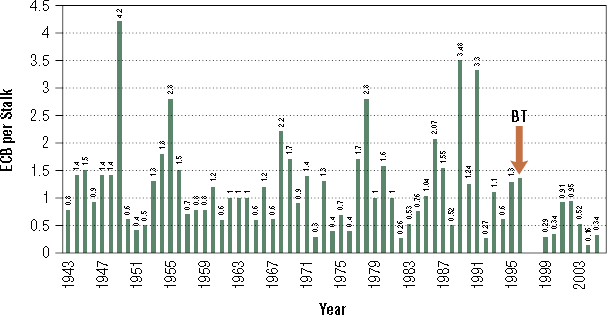
Figure 3 – Results from fall surveys for European corn borers, 1943–2005. State averages of borers per stalk; overall mean = 1.15.
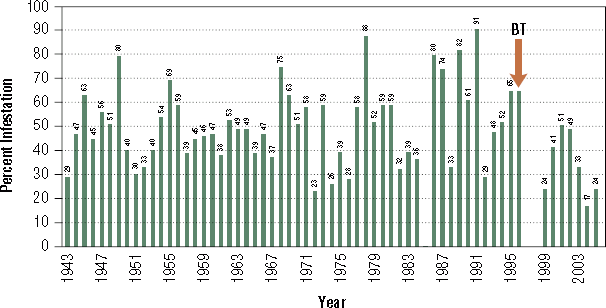
Figure 4 –Results from fall surveys for European corn borers, 1943–2005. State averages of percentage infestation; overall mean = 49.2%.
Ecologists often refer to the long-term average population of a species as the general equilibrium position. In some years, because of favorable environmental conditions and fewer natural enemies (parasitoids, predators, and pathogens), insect densities tend to increase. As densities of a population increase, they are ultimately reduced by a return of unfavorable weather, increases in natural enemies, competition within their own species for resources, or a combination of these factors. From 1972 through 1976, densities of European corn borers were low throughout Illinois (Figures 3 and 4), decades before the introduction of Bt hybrids. So, Illinois producers have experienced periods during which other population regulation factors have reduced European corn borer densities. However, surveys conducted during the past 7 years reflect a very strong downward trend in the densities of this insect pest. We may have underestimated the impact of Bt hybrids on populations of European corn borers across the Midwest.
Bt hybrids that are used to control European corn borers deliver a lethal dose of toxin to freshly-hatched larvae. High dose events (MON 810, Cry1Ab; Bt 11, TC 1507, Cry1F) used to create Bt hybrids result in considerable selection pressure on European corn borer populations and necessitate the use of refuges to delay or prevent the development of resistance. A closer look at survey data collected during the past 7 years reveals that many Illinois cornfields are virtually devoid of European corn borers. We presume these fields were planted to Bt hybrids because other cornfields in the same county often have significant infestations. To a large extent, our fall survey for European corn borers has become a survey to detect where Bt hybrids are planted and where they are not planted.
Is the use of a Bt hybrid for management of European corn borers a sound IPM practice? As the originators of the fall survey discovered, trying to predict European corn borer densities based upon these data has been frustrating. It seems highly unlikely that the use of Bt hybrids to prevent economic infestations of European corn borer will ever be based upon traditional scouting procedures and use of economic thresholds. In this sense, a traditionalist may argue that the prophylactic deployment of Bt hybrids across the Midwest is outside the IPM paradigm. However, others may argue that the use of Bt hybrids is the equivalent to host plant resistance, a cornerstone of IPM. This debate will continue in the hallowed halls of academia, and the use of Bt hybrids will soar in the United States and abroad. As profit margins become tighter and producers become even more risk averse, Bt hybrids are destined to become standard crop production inputs. We will have to re-learn a lesson from the past—over reliance on a single pest management tactic ultimately will have negative consequences.
Corn Rootworm Management with Bt Corn Hybrids
Our experiences with Bt hybrids and corn rootworms has been much more recent and over fewer years than our experiences with Bt hybrids and the European corn borer; however, a few bumps in the road have already occurred. Precise estimates of Bt (MON 863, Cry3Bb1) use for corn rootworm control are difficult to obtain. Rough estimates suggest that Bt hybrids for corn rootworms were used on 400,000 acres in the U.S. in 2003, and 2.1 million acres in 2004. During 2005, we presume that acres of Bt hybrids for corn rootworms increased; however, precise figures remain unavailable. Over the next several years, interest in Bt hybrids for corn rootworms is expected to grow, particularly in the western Corn Belt. If European import restrictions for corn rootworm transgenic hybrids can be eased, demand for these hybrids will be exceptional in the eastern Corn Belt where the variant western corn rootworm has diminished the usefulness of crop rotation as a pest management tactic.
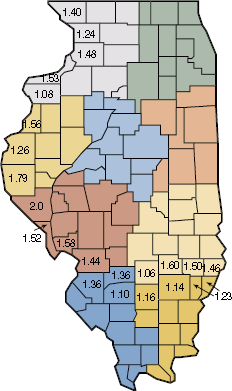
Figure 5 –Results from a 2005 survey of corn rootworm injury in first-year corn. Average root ratings for counties, 1-to-6 root-injury rating scale.
In 2005, on-farm surveys of corn rootworm injury in first-year corn were conducted in southern and extreme western Illinois counties (Figure 5). Overall, the level of root injury was low; however, these data indicate that the variant western corn rootworm is now present in many of these fields, and densities are expected to increase over time. Producers are encouraged to use Pherocon AM traps (12) in soybean fields and established economic thresholds (5 beetles per trap per day) to determine the need for a soil insecticide or transgenic corn rootworm hybrid in first-year cornfields.
Results from a survey of participants in a corn rootworm management workshop conducted in six states with distance education technology on February 4 and 11, 2005, attested to the importance that producers and the agribusiness sectors place on this insect pest. There were 97 participants in Illinois, 21 in Iowa, 34 in Minnesota, 5 in Nebraska, 21 in Wisconsin, and 17 in South Dakota. Workshop attendees were asked, "Do you believe that without management of rootworms each season on your farm, significant yield losses would occur due to larval injury? Approximately 92% responded "yes." Nearly 80% of the workshop participants who had planted a Bt hybrid for corn rootworms were satisfied with the performance of these hybrids. Bt corn rootworm hybrids were selected for a variety of reasons that included competitive cost to insecticides (13.2%), perceived superiority (20.3%), no handling and storage issues (19.9%), improved safety (19.9%), overall convenience (22.1%), and other factors (4.6%). Reasons for not selecting a Bt corn rootworm hybrid included: concern about efficacy (17.9%), refuge hassle and confusion (7.1%), elevators not accepting Bt grain (21.4%), too expensive (32.1%), and other factors (21.4%).

Figure 6 – Results from a YieldGard rootworm hybrid evaluation trial, Illinois, 2005. Planting date—April 29, root evaluation dates—July 20 and August 10, 0-to-3 node-injury rating scale.
As with any new technology, we have much to learn about Bt hybrids and their effectiveness under a wide range of environmental conditions and agronomic practices. In 2005, we evaluated nine Bt corn rootworm hybrids (MON 863, Cry3Bb1) and found some variation in brace root protection among these hybrids, particularly when we evaluated the root systems in August (Figure 6). In general, the root protection provided by these hybrids was very good to excellent. However, nearly one node of braces roots was pruned in one of the commercially available hybrids (hybrid G) evaluated on August 10. Late-season brace root pruning could lead to harvest difficulties. Two of the hybrids (C and D) had considerable brace root pruning and were never commercialized because they failed Monsanto's in-house screening tests. In 2005, observations from producers combined with the results from our experiments reflected favorably upon the performance of Bt corn rootworm hybrids under the extreme hot and dry conditions in many areas of Illinois during the critical pollination period.
As greater numbers of Bt hybrids are commercialized for corn rootworm control, including stacks and those with new events (DAS-59122-7, Cry34Ab1/ Cry35Ab1), the acres planted to these transgenic hybrids likely will increase in the very near future. Within a few years, stacked hybrids that offer protection against corn rootworms and European corn borers, as well as herbicide resistance, will become the standard pest management tactic on most corn growers' farms. Again, to many traditional "IPMers," such widespread use of single tactics for pest management lies outside the boundaries of the IPM paradigm that places such emphasis on the integration of multiple pest control tactics, along with scouting and use of economic thresholds. Although Bt hybrids for corn rootworm management can be used in a more prescriptive framework (scouting and use of economic thresholds) than Bt hybrids for European corn borer management, producers have not shown a willingness to date to embrace this concept, as evidenced by the widespread and prophylactic use of soil insecticides on continuous and rotated cornfields in Illinois.
Let's return to the question in the title, "Where's the IPM?" If we embrace the use of Bt hybrids as an example of host plant resistance, IPM implementation is increasing throughout the Corn Belt, and a huge success story is underway. If we shy away from this interpretation of IPM, then our focus in the future will not be on IPM in midwestern corn and soybean fields, but rather on insect resistance management (IRM).